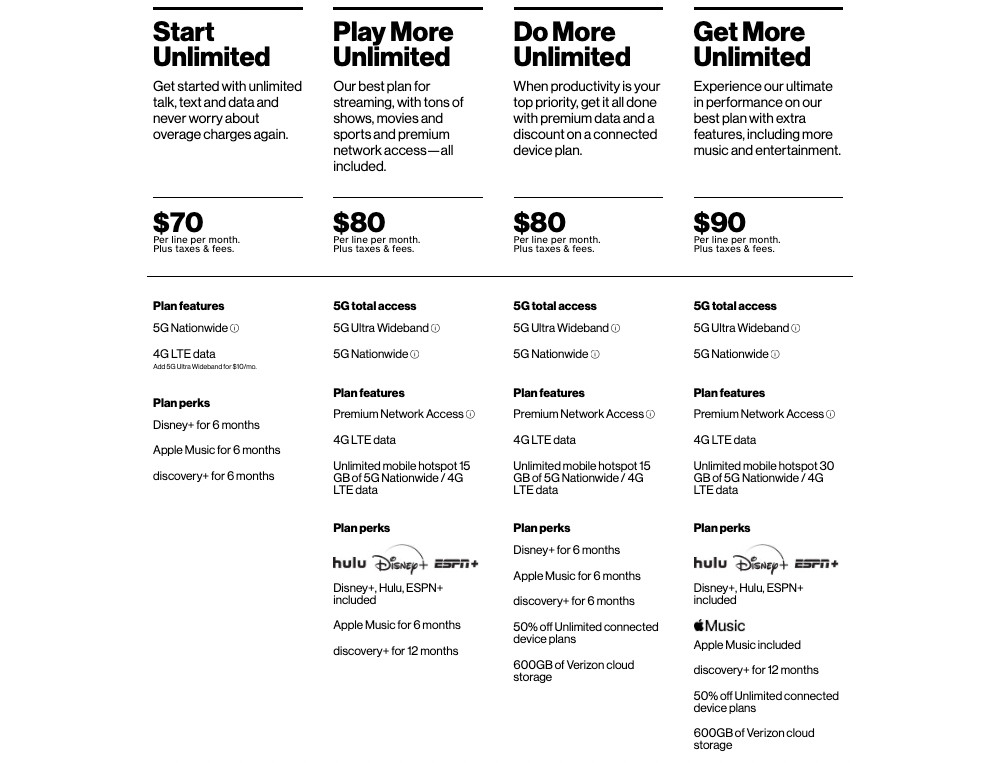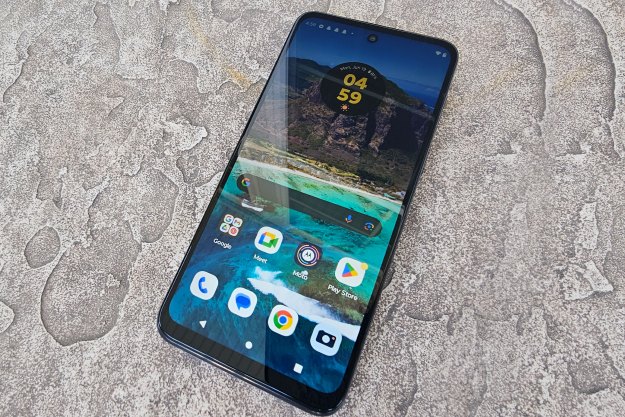Verizon has long been considered the best mobile carrier, thanks in large to its huge network. The tides, however, are changing. Verizon may offer the largest 4G network, but its 5G network has serious competition from the likes of T-Mobile — not to mention the fact that Verizon’s plans aren’t cheap.
Are you a Verizon customer interested in learning which plan is right for your needs? You’ve come to the right place. Here’s everything you need to know about Verizon’s plans.
Verizon plans

Verizon offers quite a few plans — more than either AT&T or T-Mobile. That means that its lineup can be a little more confusing, but it also means that there should be something there for you, no matter what you’re looking for.
Before diving into smartphone plans, it’s important to quickly note that you can add a Connected Devices plan to most of the below plans. Connected Devices include wearables and tablets, and the price varies depending on the device itself.
Here’s a look at Verizon’s plans:
Verizon Start Unlimited
Verizon offers four unlimited data plans, and Start Unlimited is its cheapest. All four of them have unlimited talk, text, and data, but they each offer slightly different perks.
Start Unlimited’s perks are … limited. There’s unlimited talk, text, and data, but that’s about it. You will get a six-month subscription to Disney+, Apple Music, and Discovery+, but after the six months are up, you’ll have to either pay for those services or cancelthem. On Start Unlimited, you will get access to Verizon’s nationwide 5G network, but not its Ultra Wideband network, which is built on mmWave. At this time, MmWave isn’t widely available, nor is it very reliable yet, so that likely won’t be a huge issue for most.
So how much do you pay for this no-extra-perks plan? It’s $70 per month for one line, or $45 per month, per line for three lines. That’s not cheap, especially when T-Mobile’s entry-level plan, Essentials, offers perks like hot spot usage for $60 for one line.
Subscribe to Verizon Start Unlimited
Verizon Play More Unlimited
Verizon Play More Unlimited and Do More Unlimited cost same, but they boast slightly different perks. Play More Unlimited is built for those who want access to streaming and media services.
The basics of the plan include unlimited talk, text, and data, including on Ultra Wideband. You’ll also get unlimited hot spot usage, with 15GB of 5G or 4G LTE hot spot data. Once you hit your cap, you’ll be throttled to 3G. The plan also offers 50GB of “premium data,” which means you won’t be throttled based on your data usage if you’ve used less than 50GB.
The perks of the plan take it to the next level, though. You’ll get a subscription to the Disney+/Hulu/Discovery+ bundle, and you’ll get six months of Apple Music and Discovery+.
Play More Unlimited costs $80 per month for one line, or $55 per line, per month for three lines.
Subscribe to Verizon Play More Unlimited
Verizon Do More Unlimited

Do More Unlimited offers the same foundation as Play More Unlimited, including the hot spot usage and access to Ultra Wideband. But it does away with some of the streaming perks — so instead of a full Disney+ subscription, you’ll get a six month one, alongside the six months of Apple Music and Discovery+. You get other perks instead, though, including 50% off of Verizon’s Connected Devices plans, which allows for connectivity for wearables, tablets, and so on. You’ll also get 600GB of Verizon cloud storage. Like Play More Unlimited, you’ll also get 50GB of premium data.
Like Play More Unlimited, Do More Unlimited costs $80 per month for one line, or $55 per line, per month for three lines.
Subscribe to Verizon Do More Unlimited
Verizon Get More Unlimited
Verizon Get More Unlimited is the company’s highest-end plan. It’s kind of like a combination of the Play More and Do More Unlimited plans, offering all the perks of both, and some extra stuff, too.
You’ll get a Disney+/Hulu/ESPN+ subscription, a full Apple Music subscription, and 12 months of Discovery+. You’ll also get 50% off the Unlimited Connected Devices plans and 600GB of Verizon cloud storage. Get More unlimited also doubles the amount of high-speed hot spot data you get to 30GB. Get More Unlimited keeps the same 50GB of premium data as the other plans.
Get More Unlimited is also Verizon’s most expensive plan. It comes at $90 per month for one line, or $65 per line, per month for three lines.
Subscribe to Verizon Get More Unlimited
Verizon Just Kids
Verizon Just Kids is built for parents to do things like manage screen time, track their kids’ location, and more. The plan offers unlimited talk and text to up to 20 parent-approved contacts, and allows those contacts to track the location of the kid. Apart from that, kids on the plan will get unlimited data at a download speed of 5Mbps.
Just Kids is quite expensive for what it offers. It costs $50 per line on plans with two lines or more (one of those lines being the parent’s). It drops as low as $25 per month on a plan with five lines or more.
Verizon Shared Data
Verizon also offers a few shared data plans, which allow users to get unlimited talk and text, as well as share data among the lines on the plan. There’s a 5GB shared data plan, which costs $55 for one line or $105 for three lines, and a 10GB shared data plan, which costs $65 for one line or $115 for three lines.
Verizon Prepaid Phone Plans
Last but not least are Verizon’s prepaid phone plans. These plans don’t offer too many perks, but they’re also a little cheaper than their post-paid plans.
The cheapest is a 5GB prepaid plan, which costs $35, and includes access to Verizon’s 5G network. It also includes hot spot use, but it’s limited to the data available in the plan.
Next up is the 15GB prepaid plan, which costs $45 per month and includes the same perks as the 5GB plan. It also adds talk to Mexico and Canada.
The Prepaid Unlimited plan costs $60 per month. This plan includes talk, text, and data to and from Mexico and Canada, and while it doesn’t have hot spot usage, you can add it for $5 per month.
These plans don’t offer too many perks, but they’re also a little cheaper than its post-paid plans.
Last but not least is the $70-per-month Prepaid Unlimited plan, which adds access to Ultra Wideband, and includes hot spot usage.
Verizon coverage
Verizon has traditionally been known as the carrier with one of the largest networks, and that remains true today. But that may be changing — with its absorption of Sprint, and its launch of the first nationwide 5G network, T-Mobile may be hot on Verizon’s heels.
Verizon’s coverage is still excellent, and if you’re in a rural area or regularly travel to one, you may only have access to Verizon.
You can see Verizon’s full coverage map straight from its website.
How Verizon compares to T-Mobile and AT&T
Verizon may offer some perks with its plans, but those perks come at a price — generally speaking, you can get the same or more for less on T-Mobile, especially if you don’t really want or need access to services like Disney+ and Apple Music. T-Mobile does, however, have a deal with Netflix, so you can get a Netflix subscription of some kind on T-Mobile’s $70 Magenta or $85 Magenta Max plans.
AT&T’s plans are a little cheaper than Verizon’s, too — though again, the perks are a little different. AT&T does offer access to HBO Max, but only on its most expensive plan, so if getting access to a streaming service is appealing to you, you may need to shell out some cash.
Editors' Recommendations
- Visible’s affordable 5G plans just got even cheaper
- This new folding phone costs less than half the price of the iPhone 15 Pro Max
- Does the Moto G Power have NFC?
- Does the Moto G Stylus have NFC?
- The best Moto G Power 5G (2024) cases: 7 great choices


